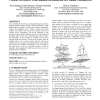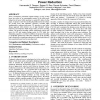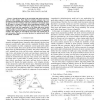23 search results - page 4 / 5 » Optimal wire sizing and buffer insertion for low power and a... |
GLVLSI
2009
IEEE
14 years 1 months ago
2009
IEEE
Clock distribution networks are an important design issue that is highly dependent on delay variations and load imbalances, while requiring power efficiency. Existing mesh solutio...
ICCAD
2005
IEEE
14 years 3 months ago
2005
IEEE
— Although the LUT (look-up table) size of FPGAs has been optimized for general applications, complicated designs may contain a large number of cascaded LUTs between flip-flops...
DAC
2004
ACM
14 years 7 months ago
2004
ACM
Power consumption, particularly runtime leakage, in long on-chip buses has grown to an unacceptable portion of the total power budget due to heavy buffer insertion to combat RC de...
ASPDAC
2007
ACM
13 years 10 months ago
2007
ACM
Parallel prefix adder is the most flexible and widely-used binary adder for ASIC designs. Many high-level synthesis techniques have been developed to find optimal prefix structures...
CASES
2007
ACM
2007
ACM
INTACTE: an interconnect area, delay, and energy estimation tool for microarchitectural explorations
13 years 10 months ago
Prior work on modeling interconnects has focused on optimizing the wire and repeater design for trading off energy and delay, and is largely based on low level circuit parameters....



